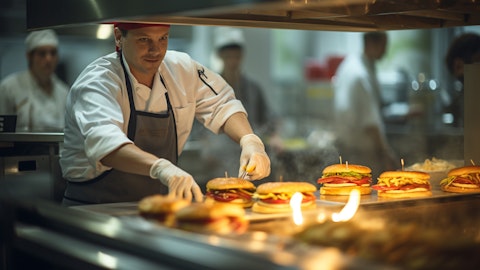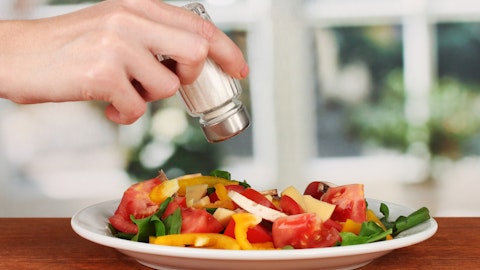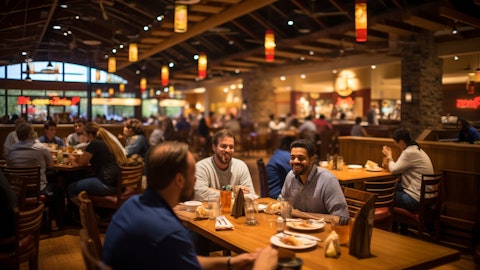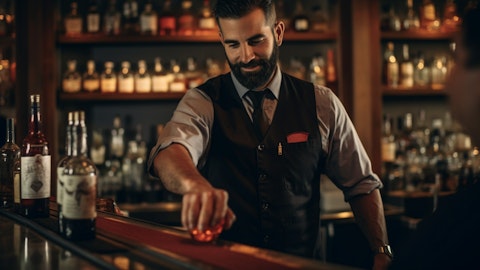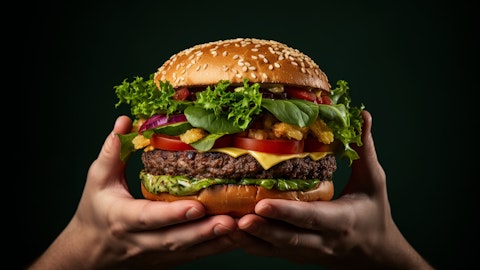Katie Fogertey: Sure. So yeah, we talked about low-single digit price that we’re expecting for the year, down traffic, we’re goaling ourselves, we’re targeting to have positive traffic. We’ve embedded some ranges, though, on that side in that guide. And kiosk overall, I have to say, we’re really excited by what it continues to provide for us. Our sales on kiosk in the fourth quarter doubled year-over-year and we implemented some new technology upgrades in that channel to continue to drive increased attach rates and customization. But we’ll have to see how that continues to play out through the rest of the year.
Operator: Our next question comes from Jake Bartlett with Truist Securities. Please [Technical Difficulty]
Jake Bartlett: Great. Thanks for taking the question. On the margin expansion guidance for ’24, great to see that, I’m wondering if you can just help us understand what’s driving it. It looks like just COGS, or commodity cost inflation being flat to low-single digits and low-single digits price would be a contributor. So, if you could maybe disaggregate the drivers, including what you’re proactively doing, some of the supply chain initiatives, labor initiatives, just trying to kind of understand more specifically what your actions are doing to your margin outlook.
Katie Fogertey: Yeah. Absolutely. So first of all, again, really excited to have the strategies in place and the confidence here to sit here and guide for 20% to 21% Shack level operating profit margin for 2024, marking another year of continued profitability improvement. I think when we go through the P&L, on food and paper, we put our inflation outlook to be flat to up low-single digits year-over-year for the full year. It’s important to note, though, that our initiatives that we’re doing on supply chain, whether it’s increasing the number of suppliers, optimizing our freight and other initiatives are driving that to be to the flat to up low-single-digit level. We would have been in a worse position had we not had these operational improvement programs already in place.
The one thing I’ll caveat there, though, is that beef is the largest uncertainty to that basket and it’s something that we are watching closely. On labor, we have been driving very strong flow through as a result of our increased — better overall sales forecasting and our better deployment and just really leveraging increased sales and traffic that we’ve seen overall at the company. So those are two areas where we really do expect to show continued improvement in 2024. Also, both areas where we are facing inflationary pressures on wages particular, we’re kind of anticipating a low-single-digit increase, but we all know that there’s certain areas of the country that are going up a lot more than that, and with the programs that we have in place, we’re confident in our ability to navigate these continued inflationary waters.
Operator: Our next question comes from Peter Saleh with BTIG. Please [Technical Difficulty]
Peter Saleh: Great. Thanks. Thanks for taking the question. I did want to come back to the advertising discussion. I think in 3Q, Shake Shack targeted more advertising in the West, can you just give us a sense on where you were spending the incremental dollars or where you were testing some more advertising in 4Q? And just, in terms of 2024, are you targeting specific regions or how do we think about your spending on advertising next year or this year rather?
Randy Garutti: Yeah. Thanks. To answer your question, last year, yeah, we continued some of those tests on the West Coast that we saw some strong return for. We did some things in Texas, that’s been a big growing market for us. We opened a lot of restaurants in Texas last year, so there was appointed tests and learned happening there. And for this year, we will keep you posted. I think the teams continue to learn on that. A lot of this is really directed at the markets where we think we can have the highest return, balanced with some spend, where we have lower brand awareness and we just want to make sure that we keep hitting those and having people know who we are, what we do, and driving the exciting opportunity we have. Sometimes it’ll go along with openings, our new Shack openings, where those go where we choose to spend.
But generally, it’s really a lot of one-to-one performance marketing digital opportunities that we see where most of the ramping of spend will go. We think that’s the best way to do it at this scale. So when we hear the word advertising, it’s not going to be a whole lot of TV commercials and the things you might traditionally think. At this scale, most of the best way we can gain is on digital channels that we’ve seen strong returns on.
Operator: Our next question comes from Brian Harper with Morgan Stanley. Please [Technical Difficulty]
Brian Harper: Yeah. Thank you and good morning. With kind of the improving traffic trend in the fourth quarter, what do you think was most impactful to that, maybe it was some of the advertising, but just curious for your thoughts there. And I know that there was a little bit of divergence between New York and the other regions and if you had any thoughts on kind of what drove that.
Randy Garutti: Well, I think these are the things that we’ve been pointing out through the call today. I think they’re all of those things. We had a good LTO. We had strong and improving comp through the quarter. We had a lot of that advertising targeting, various different promos, and opportunities that we’ve shared both in our channels and in other channels. So I think it’s been a really well played playbook by our marketing team. And again, a lot of that, as we keep saying on this call, increasing the overall spend to get us to a point where we can continue to test and confidently employ data-driven, disciplined spend across our marketing channel. So I think that was really a good part of the Q4 and just a solid lineup of operational execution across the company.
Katie Fogertey: And then in New York specifically, we’ve been opening a number of restaurants, so we’ve kind of put some of those pressures there, it’s more on the infill pressures, things that we’ve normally seen throughout the year.
Operator: Our next question comes from David Tarantino at Baird. Please proceed with your question.
David Tarantino: Hi. Good morning. You made really impressive progress on improving the shop level profitability, so I was just wondering if you could maybe frame up where you think you are in your journey to improve profitability. And I think, Randy, you mentioned a reference to getting back to pre-COVID profitability, and I’m just wondering, if we should be reading that as your goal. I think you had 22% shop level margins or slightly higher than that in 2019, is that the right way to think about your goals or I guess, any way to frame up kind of the long term picture on profitability? Thanks.
Randy Garutti: Thanks, David. I think the goal is 20% to 21% this year in 2024. That’s the clear guide. That’s what we’re working on. As we’ve said in the call, lots of initiatives that have been working and lots more that are coming, both to expand upon the current, as well as add new things and we’re really clear in the notes today about what those look like. Look, we know we had a higher Shack-level ops profit overall pre-COVID, companies twice the size right now, changed a lot, and we’re going to continue to drive that. Our goal will always be to continue to expand on that profitability. That’s what we’ve shown this year, over 240 bps of leverage this year and targeting and guiding for more this year. Lots of opportunity left in the tank and we want to do it deliberately and in constant with the overall successful growth that we’ve had, so it’s a profitable growth journey overall.
Operator: Our next question comes from Jeffrey Bernstein with Barclays. Please proceed with [Technical Difficulty]
Jeffrey Bernstein: Great. Thank you very much. Just focusing on the cost side of things, actually, a two part question. The first, Randy, you mentioned the unit cost build reductions of 10%, which you’ve talked about before, just wondering if there are any concerns. I know you like to enter markets with the wow factor, so I’m just wondering, where the biggest opportunity in the front and the back of the house is to pull out that 10% plus. And then just to follow-up, Katie, you mentioned G&A leverage again in ’24, which is clearly impressive considering your outsized growth, I’m just wondering if you could bucket the primary areas of opportunity relative to that revenue growth, so the leverage that you’re expecting to achieve there. Thank you.
Randy Garutti: Thanks, Jeffrey. Yeah. We love to open with the wow as you said. We’ve had a history of doing that pretty well, want to continue to do that. We’re going to build beautiful restaurants. These goals do not take away anything from the differentiating factor we believe is critical to Shake Shack, which is we just don’t look and feel like fast food. We are serving a premium product and a premium experience, we’re going to continue to do that. I think where the team’s been targeting, obviously, we’ve dealt with a tough construction environment. Every company you talk to is dealing with the same thing, ours is no different. But we’ve also increased some of our more expensive formats and drive throughs. So, as I’ve said, a lot of the work is nuts and bolts in the guts of the building that you won’t ever see or appreciate that we are figuring out how to do more effectively and efficiently by carving out time.
Some of the things, I still don’t think you’ll notice, but what we know we can do now after learning quite a bit in this last few years as we’ve ramped our growth, is taking down the overall size of some Shacks, taking down some of the complicated factors of some Shacks as we learn what our guests really want, how often, and provide for peak opportunity. There’ll be a good mix this year of our core Shacks, which you kind of know and love, and what we do, as well as some of the drive throughs, where we want to continue to expand. Again 2024, these restaurants were designed a year or two ago, and is not as much immediate opportunity. So we feel real good about what the team is delivering at this approximately 10% target goal, including, by the way, our pre-opening expenses, which we know we can save upon.
But as we get into ’25 and beyond, we think we’ll start to harvest even more of that, and that’s the goal. We think that it is just a lot of opportunity for us to continue to build the dynamic wow restaurants that differentiate while taking cost down. So that is the commitment and our team is working hard on it.
Katie Fogertey: And on your question on G&A, what you probably have surmised from our conference call today and then also our materials is that, we really continue to put a priority on investments that drive sales and drive the future growth of our restaurants. And so we’re continuing to take a very disciplined approach to that. You will see it in our G&A investments and in other parts of the P&L. So again, it’s about taking a meaningful step up in advertising expense, but at the same, kind of on the run rate side of the business, being very prudent, very disciplined about the investments that we’re making there so that we can prioritize the investments needed for the long term growth of the company.
Operator: Our next question comes from Jeff Farmer with Gordon Haskett. Please [Technical Difficulty]
Jeff Farmer: Yeah. Good morning, and thank you. Just another follow-up on menu pricing. Katie, I think you mentioned 2.5% pricing for the majority of the system in 2024, but inclusive of the pricing in the California restaurants, and I think you guys just mentioned the 3PD menu price increase, what would that equate to for total system pricing in 2024?
Katie Fogertey: Yeah. So, what we’re thinking about that 2.5%, so first of all, there are two numbers that are 2.5% here. So first of all, 2.5% is what we’re kind of targeting for about realized price for 2024. There’s going to be some areas where we’re taking more than that to offset wage inflationary pressures. You talked about California scenario, where they’re taking it up a lot in some of our markets, and we’re going to be taking price there to help offset those pressures. We also increased the premium we were charging on our digital channels. We’re still underpriced relative to kind of our peer average. I still think we have room on that side, but continue to test and learn in that channel. And then overall, the other 2.5% dimension is that’s pretty much your average Shack outside of a big wage inflationary zone.
That’s about the overall price that we’re looking to take this year, and that’s very consistent with the pre-COVID pricing patterns that we’ve had. So most of our shacks will have kind of that lower-single digit menu price increase this year.
Operator: Our next question comes from Andy Barish with Jefferies. Please proceed with your question.
Andy Barish: Yeah. Good morning. I guess for Randy, although, this may change as you hand over the reins, is 40 company owned units kind of the right pace that the company is sort of settling into, just kind of looking at teams and retention and operational consistency and all those kind of things or is there something as bill costs, maybe come down that could accelerate that?
Randy Garutti: Well, we’re not going to guide past this year. 40 is a number we like. We obviously pulled forward a little bit this year and got to 41 for the company operated domestic. On license, we pulled forward a bunch and got to 45, well ahead of guidance. We think 40 is a good number there as well. So you look at kind of 85 restaurants last year, about 80 this year, we like that number. That doesn’t mean anything about what we will choose to do next year. Let’s talk about what we’re looking at. We’re building a pipeline for the future that will allow us to continue to grow with strong return. As I noted in my comments, I think it’s important to say, when you — we’ve taken this last couple of years to sort of pull back a little bit, and say, okay, cool, what have we learned?
Our restaurants have got more expensive. How are we going to make them less expensive and how are we going to do them better, so that we can open better restaurants over time with stronger returns for the long term, and that process has unfortunately caused what will be a back weighted sales year this year. So a lot of the new Shack sales will come at the back end of the year. But that was smart work. That was work to make sure that we were investing with discipline and putting our CapEx to work in the right places. So, we really like that. I won’t speak for what’s ahead other than this year we feel good about the 40.
Operator: Our next question comes from Jim Sanderson with Northcoast Research. Please proceed.
Jim Sanderson: Hey. Thanks for the question. Congratulations on a great quarter. I wanted to go back to the combo testing, just if you could provide some more insights on, what metrics you’re testing, whether this is looking at discounts to a la carte or if you’re trying to build kids meals, family bundles that might move average Shack up? Just any thoughts on the test and how this might impact average Shack going forward? And also why only through the drive-through? Thank you.
Randy Garutti: Yeah. Thanks, Jim. And again, this is not going to be, do not expect any material rollout of this strategy this year. This is something that we really want to learn into. This is not something you flip on and off easily in a company like ours, who’s never done it. So what are we looking for? Number one, we’re looking for do our guests want to order that way, right? That’ll be the kind of first KPI we have. Then we’re going to look at various pricing strategies. Do we need a discount or is it really just about ease of ordering? Testing various levels of a bundled discount and how that feels of that Shake Shack. Can we increase items per Shack, right? What happens to both beverage and shake attached? This is Shake Shack, right, and we’re different.
We sell a lot of shakes. What happens in the combo meal environment in shakes? These are things we’re looking at. And ultimately, can it contribute to a better ticket time, right? Does it help our team in the back as well as the person ordering? And I think where you see the most pressure of ordering time is always at a drive-through window, right? In most of our other channels, especially now with kiosks, it’s a lot more relaxed ordering process. You don’t have to feel like you got to move forward, but in a drive through, you inevitably feel that way, and so that’s why we’re testing it at drive-through. So it’s only that kind of a couple handfuls of our restaurants I expect it’ll kind of stay at that test level for some period of time and we’ll look at it.
